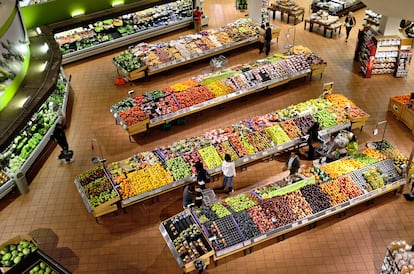“Avoid consumption”. No half measures: don’t eat it. This is the most powerful – and requested – mention that the Chilean government requires to be included in advertising about unhealthy foods since Decree 24 came into force in April this year. An alarming warning for the ultraprocessing industry, which is putting pressure on public administrations around the world not to implement clear and definitive labeling systems that alert the population to the harmful effects of their products. As Chilean legislation changes, the volume of warnings on packaging increases, forcing the industry to confront what it has been trying to avoid for years: calling things by their name.
Let’s remember this. Since the entry into force of Law 20.606 on the nutritional composition of foods and their advertising in 2016, on the shelves of Chilean supermarkets one could find packages that on the most visible side included conspicuous black octagons warning that the product was “high in sodium”, “high in saturated fat”, “high in sugar” or “high in calories”. Real warning signs that were impossible to ignore, indicating that sodium, sugars or saturated fats had been added to the product and that the final content of these nutrients exceeded the limits established by food health regulations.
The black octagons warned on their own and the advertisement reinforced the message as it had to mention “Prefer foods with fewer warning labels”. With decree 24, what was previously an advertising suggestion becomes a clear appeal: “Foods with the words “high in” should be avoided.” Retro Ford. A thunderous scream with no possibility of interpretation. Naturally, the Chilean food industry did not like this new rule at all and the companies Unilever, Nestlé, Carozzi and Tres Montes filed legal appeals to revoke the decree.
However, a few days ago, the Court of Appeal of Santiago de Chile rejected their claims and argued, among other things, that “the decree in question does not prevent the appellant companies from carrying out their commercial activities, nor from marketing their products, nor introduces disproportionate or discriminatory restrictions (…) all with the aim of more effectively orienting the population on such a delicate issue as nutrition”.
Avoid the “avoid” message.
The mere idea that the message “avoid” is associated with a food product is the most terrifying nightmare of that part of the food industry that designs foods that are harmful to health. It blows up an entire universally used communication strategy, where the main goal is for its products not to be identified as unhealthy. That’s why he worked for decades to generate an entire narrative centered on three axes: ambiguity, externalization of harm and individual responsibility.
Ambiguity that clings like a tick to the idea of ”eating in moderation”, a concept impossible to quantify and which includes everything, even “eating everything”. The second leg, the externalization of damage, which is when they attribute the lack of health not to their product, but to the diet in general or to a sedentary lifestyle (we have already talked about these and other errors of the food industry, such as that there are no “good” foods and “bad” foods in El Comidista). Individual responsibility also appears, loudly proclaimed, when they assure that the final decision to eat something lies with the consumer: as if they had not worked fervently and put all their resources into action to ensure that this freedom of choice was totally flawed.
As Marion Nestlé explains in her essential book Food policythe message “consume less” (of a certain food) directly conflicts with the interests of the food industry, which seeks to induce consumers to increase the consumption of its products.’ These interests have successfully interfered and shaped the dietary recommendations of several governments thanks to the pressures and influences of these companies on politicians, regulators and public organizations.
It is no coincidence that recommendations aimed at establishing restrictions focus on nutrients and not foods. Nestlé continues: “the ‘eat less beef’ message angers the industry, while the ‘eat less saturated fat’ message does not generate the same confrontation.” Which advice is easiest to follow when choosing products? “This food can be included in a balanced diet, accompanied by exercise and healthy habits” or “avoid this food”. There are no further questions, Your Honor.

Why does the food industry care about seals?
For one fundamental reason: they don’t create confusion. Contrary to what happens with systems like NutriScore, the warning seals do not relativize, they do not establish a “healthy” gradient with a whole gray area that is difficult to interpret. The seals are unequivocal: either he is healthy or he is not. They understand each other at a glance and don’t require you to know how the system works to understand what it’s telling you. Furthermore, studies like this one explain that its mere presence already discourages purchasing, and in this other they underline that front labeling has a greater impact on the choice of healthy products. Stamps don’t educate, they interrupt. And that lack of nutritional education that the industry points to as a handicap; because they are very careful that we understand all the information well to understand what their product is, obviously this is precisely what makes them effective.
I do not want to overlook a fundamental approach: the deterrent effect of warning labels does not require prior nutritional knowledge, which helps the most vulnerable consumers – people with low nutritional literacy, low education level, low income or population from marginalized rural or urban backgrounds – to make healthy food choices. Front seals that fight inequalities. It’s not a small thing (if you want to learn more you can consult studies like this one or this one).
Does this mean I’m against nutrition education? At all! We need strong policies from childhood, regulations that require labels to be clear and understandable, incentives that promote the purchase of healthy foods and sanctions for the most harmful products. But as these – and other – measures are established, having tools that truly discourage unhealthy consumption continues to be a viable strategy.

History repeats itself
Chile is not an isolated case. As collected in Analysis of stakeholder responses to food warning labeling regulation in Mexicowhen the inclusion of warning stamps was proposed and put out for public consultation in that country in 2019, the food industry and non-governmental organizations with commercial purposes or interests, i.e. those representing the interests of the private sector such as business chambers, industrial associationsthink tank funded by multinationals – were vehemently opposed, citing economic losses and arguing that the new labeling would confuse consumers.
On the other side of the coin was the view of academia, healthcare professionals and NGOs and their opinion was diametrically opposed: the new labeling was essential to inform consumers and was an important element in reducing the prevalence of overweight and obesity. It is rhetorical to ask who had profitability in mind and who had public health in mind. Not surprisingly, this investigation states that the industry has worked to delay implementation of the standard and has identified it as a key barrier, and of course, in Mexico, food companies have also filed lawsuits against warning labels.
We could continue to give examples because the modus operandi It’s always the same. Faced with the possibility that a government will consider instituting labeling that clearly identifies unhealthy foods, the food industry implements machinery that does not stop even when the measure is law. The pattern repeats itself: first, lobbying actions aimed at blocking its implementation or replacing the warning system with a more benign one, such as the nutritional traffic light.
Then, media campaigns that try to generate social rejection, spreading distorted information but presented as neutral, often supported by authoritative voices, such as nutritionists or doctors. Then comes a new round of political pressure to delay entry into force and, if despite all the labeling it manages to pass “the twelve Asterix tests”, the process is judicialized, with the aim of suspending, delaying or softening the aspects most harmful to its interests.

It’s not (just) profitability, it’s history
While the food industry seems very concerned about what will happen to their sales if this labeling is imposed – while simultaneously threatening to have to make staff cuts – the facts point in another direction. A study published in Nutrients analyzed the effects of Chile’s “warning stickers” on employment, real wages and corporate profits, and concluded that there were no negative impacts three years after their implementation.
They are also very worried (note the irony) that consumers have less information available, that this creates more confusion, that it threatens the free market, or against freedom of expression (yes, this idea is used here too), that alone it will not solve the problem of overweight and obesity… or that it stigmatizes some products with labels similar to those on tobacco packaging. Considering the closeness between the two industries, the coincidence of their moves to clean up their image through funded studies to question the harmful effects of their products, their discourse centered on “individual responsibility,” and emphasis on creating supposedly “less harmful” products, the comparison is not exaggerated: it is, in fact, accurate.
Maybe what the industry really fears isn’t having to change a formula or redo a label. His deepest fear is losing history. That story that for years – and millions of advertisements – has presented its products as synonymous with well-being, happiness or health. Because a black seal is enough for all that carefully constructed fiction to collapse and, finally, to see what was behind it: a brilliant business, yes, but also a risk to public health.
Follow El Comidista on YouTube.



